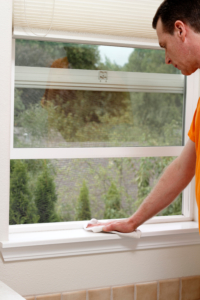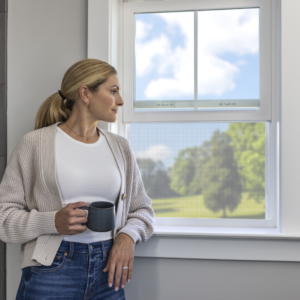The Surprising Way to Protect Your Home from Poor Outdoor Air Quality
Air quality conditions are a year-round concern due to several different pollutants. However, the recent wildfire smoke infiltrating the United States has brought the topic to the forefront of everyone’s minds. Many people are heeding the warnings and taking precautions by minimizing outdoor time, utilizing air filters, and keeping pets inside. There’s another surprising way to protect your family and home from poor air quality: your window screens. Read on to learn about the impact of outdoor air quality and how your window screens can help keep the air inside your home cleaner.
What You Need to Know About Air Quality
What Causes Poor Air Quality

- Wildfires: Wildfires have a profound impact on air quality and are a significant cause for concern due to smoke, particulate matter, and hazardous gases like carbon monoxide, and volatile organic compounds. These pollutants can travel long distances, posing health risks to communities nearby and downwind. In addition to individual health concerns, this smoke can lead to reduced visibility, contribute to smog formation, and impact local weather patterns, making wildfires a significant problem for air quality management and public health protection.
- Allergens: Common sources of outdoor airborne allergens include pollen, mold spores, and outdoor fungi, all of which have a significant impact on the health and well-being of those with these allergies. Many people with severe reactions monitor the pollen forecast to stay informed about air quality and potential allergen exposure . They may even have to stay inside on days with high levels.
- Pollution: Outdoor air pollution is mainly caused by human activities such as industrial emissions, transportation, agricultural practices, and waste burning. These activities release harmful pollutants, such as sulfur dioxide, nitrogen oxides, and particulate matter, leading to environmental and health problems. Urban areas, industrial zones, and regions near highways are more likely to experience higher levels of air pollution.
How Air Quality Is Evaluated
How do you know if you must worry about air quality on any day? The measure of air quality is called the Air Quality Index (AQI) and is leveled based on values from 0-500, with zero being the healthiest and 500 being the most dangerous. AQI levels include:

- Green (0-50) Good: Air quality is considered satisfactory, and air pollution poses little or no risk. Most people can engage in outdoor activities without health concerns.
- Yellow (51-100) Moderate: While air quality is acceptable, there may be a slight concern for some sensitive individuals, like children, older people, and those with respiratory conditions. These groups should try to limit prolonged outdoor activities.
- Orange (101-150) Unhealthy for Certain Groups: This level is considered unhealthy for the same groups above, and they experience health issues. Outdoor time should be limited for those people.
- Red (151-200) Unhealthy: Everyone may begin to experience health effects, and members of sensitive groups may experience more severe health issues. Outdoor activities should be limited for all individuals.
- Purple (201-300) Very Unhealthy: Health alert! The entire population will likely be affected, and people are advised to avoid outdoor activities. Emergency measures may be implemented to reduce exposure.
- Maroon (301-500) Hazardous: – Health warnings of emergency conditions. The entire population is at risk of severe health effects, and everyone should avoid any outdoor activity.
How Poor Air Quality Impacts Health
Allergens, pollutants, and wildfire smoke can cause a variety of health issues, some inconvenient and others incredibly dangerous:

-
- Sneezing
- Runny or stuffy nose
- Itchy or watery eyes
- Coughing
- Wheezing
- Rashes
- Asthma attacks
- Lung cancer
- Hearth disease
- Premature deaths in severe cases
- And more symptoms that are causes for concern
You should work with your doctor to devise preventive and treatment plans, and seek help immediately if you experience any severe symptoms.
Window Screens: The Surprising Way to Protect Your Home from Poor Outdoor Air Quality
A new model of specially treated window screens has been created to filter pollution from the air to help keep 90% of harmful particles out of your home. The fibers are developed with polymers containing nitrogen, which are then sprayed with a stream of air that stretches out droplets of the solution to form an extremely thin layer of nanofibers using a process called blow-spinning.

Scientists at Stanford University and Tsinghua University in Beijing developed this one-of-a-kind screen. The efficacy was tested over 12 hours in Beijing with severely hazy air conditions, and the screen filtered 90% of the harmful particle matter. The researchers were even able to wipe away the pollutants nanofibers with tissue papers.
You can learn more about this incredible technology from Scientific American.
Are You Ready to Explore New Screen Options?
If you’ve determined it’s time to replace your window screens, you don’t need to reach for your phone to call a professional! In fact, replacing your window screen is an easy DIY project with help from Ritescreen. RiteScreen offers the widest selection of custom fitting window screens on the market, and with our extruded metal you can rest assured you’re receiving the highest end window screen available. Simply visit our RiteScreen Store and select your window screen, or visit the RiteScreen store on Amazon, choose between custom or adjustable window screens, and have your new window screen delivered to start your DIY window screen replacement project!







